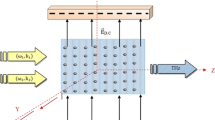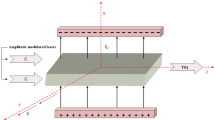Abstract
A novel scheme for electric field-induced strong terahertz (THz) emission by beating two filamented spatial-Gaussian laser beams (with intensities \({10}^{14} {\mathrm{W cm}}^{-2})\) in the pre-existing underdense magnetized plasma is proposed. The coupling between the nonlinear density and nonlinear velocity of the plasma electrons results in the strong nonlinear current which drives the efficient THz radiation in the presence of the D.C. electric and magnetic fields. The contribution of the electron temperature on the THz generation has been investigated. The modulation index also makes a significant contribution to the enhancement of the nonlinear current density and normalized THz amplitude. With the help of a magnetic field, D. C. electric field, D.C. drift speed, and modulation index, one can easily tune the THz radiations for medical and astronomical applications. The normalized amplitude of emitted THz radiation is observed to vary with the externally applied electric field, magnetic field, normalized frequency, drift velocity of electrons, thermal velocity of electrons, temperature of plasma electrons, and modulation index of incident laser beams. The frequency of the emitted THz radiation (corresponding to \(25.0\mathrm{ kG}\)) is found to lie in the frequency range of molecular rotational and vibrational spectra of deoxyribonucleic acid. As a result, emitted THz radiation in the present scheme can play an important role in developing a new technique to distinguish between healthier and non-healthier tissues of human beings. The emitted THz radiation shows sensitive behavior toward water particles. Due to this, emitted THz radiation can also be used to detect water at the surface of the earth as well as on other celestial bodies.






Similar content being viewed by others
Data availability
The data that support the findings of this study are available from the corresponding authors upon reasonable request.
References
A.R. Orlando, G.P. Gallerano, J. Infrared Millim. Terahertz Waves 30, 1308 (2009). https://doi.org/10.1007/s10762-009-9561-z
V. Thakur, S. Vij, N. Kant, S. Kumar, Indian J Phys 97, 2191–2196 (2023). https://doi.org/10.1007/s12648-022-02575-x
P.H. Siegel, IEEE Trans. Microw. Theory Tech. 50, 910 (2002). https://doi.org/10.1109/22.989974
K. Ishigaki, M. Shiraishi, S. Suzuki, M. Asada, N. Nishiyama, S. Arai, Electron. Lett. 8, 582 (2012). https://doi.org/10.1049/el.2012.0849
E. Pickwell, V.P. Wallace, J. Phys. D: Appl. Phys. 39, R301 (2006). https://doi.org/10.1088/0022-3727/39/17/R01
M. Kawase, Food Sci. Technol. Res. 18, 601 (2012). https://doi.org/10.3136/fstr.18.601
N.C. Hoffmann, J. Fulop, Phys. D: Appl. Phys. 44, 083001 (2011)
P.H. Lui, F.A. Hegmann, Appl. Phys. Lett 78, 3478 (2001). https://doi.org/10.1063/1.1375841
D. Dragoman, M. Dragoman, Prog Quant. Electron 28, 1–66 (2004). https://doi.org/10.1364/AO.43.003848
F. Sizov, Opto-Electr. Rev. 18, 009–0029 (2010). https://doi.org/10.2478/s11772-009-0029-4
R.K. Singh, S. Kumar, R.P. Sharma, Contrib. Plasma Phys. 57, 252–257 (2017). https://doi.org/10.1002/ctpp.201700029
S. Kumar, S. Vij, N. Kant, V. Thakur, Plasmonics 17, 381–388 (2022). https://doi.org/10.1007/s11468-021-01529-z
S. Kumar, S. Vij, N. Kant, V. Thakur, Chin. J. Phys. 78, 453–462 (2022). https://doi.org/10.1016/j.cjph.2022.06.004
S. Kumar, S. Vij, N. Kant, V. Thakur, Phys. Scr. 98, 015015 (2022)
S. Kumar, S. Vij, N. Kant, V. Thakur, Waves Rand. Complex Media (2022). https://doi.org/10.1080/17455030.2022.2155330
S. Kumar, S. Vij, N. Kant, V. Thakur, Braz. J. Phys. 53, 37 (2023). https://doi.org/10.1007/s13538-022-01252-y
S. Kumar, N. Kant, V. Thakur, Opt. Quant. Electron 55, 281 (2023). https://doi.org/10.1007/s11082-023-04562-w
S. Kumar, S. Vij, N. Kant, V. Thakur, Opt. Commun. 513, 128112 (2022)
M. Amouamouha, F. Bakhtiari, B. Ghafary, AIP Adv. 11, 125219 (2021)
M. Kumar, V.K. Tripathi, IEEE J Quant. Elect. 48, 1031–1035 (2012). https://doi.org/10.1109/JQE.2012.2192471
M.C. Gurjar, K. Gopal, D.N. Gupta, V.V. Kulagin, H. Suk, IEEE Trans. Plasma Sci. 48, 3727–3734 (2020). https://doi.org/10.1109/TPS.2020.3022903
D.N. Gupta, V.V. Kulagin, H. Suk, Opt. Commun. 401, 71–74 (2017). https://doi.org/10.1016/j.optcom.2017.05.043
A. Kumar, A. Kumar, A. Verma, Laser Phys. 31, 106001 (2021)
A. Kumar, S.P. Mishra, A. Kumar, A. Varma, Optik 273, 170436 (2023)
A. Varma, A. Kumar, Optik 231, 166326 (2021)
S. Kumar, S. Vij, N. Kant, A. Mehta, V. Thakur, Euro. Phys. J. Plus 136, 148 (2021). https://doi.org/10.1140/epjp/s13360-021-01089-5
S. Kumar, S. Vij, N. Kant, V. Thakur, J. Astrophys. Astr. 43, 30 (2022). https://doi.org/10.1007/s12036-022-09805-y
T.J. Wang, J.F. Daigle, S. Yuan, F. Théberge, M. Châteauneuf, J. Dubois, G. Roy, H. Zeng, S.L. Chin, Phys. Rev. A 83, 053801 (2011)
P. Varshney, V. Sajal, P. Chauhan, R. Kumar, K.N. Sharma, Laser Part. Beams 32, 375–381 (2014). https://doi.org/10.1017/S026303461400024X
D. Tripathi, L. Bhasin, R. Uma, V.K. Tripathi, Phys. Scr. 82, 035504 (2010)
S. Kumar, N. Kant, V. Thakur, Phys. Scr. 98, 085506 (2023)
A. Braun, G. Korn, X.D. Liu, J. Squier, G. Mourou, Opt. Lett. 20, 73–75 (1995). https://doi.org/10.1364/OL.20.000073
A. Houard, Y. Liu, B. Prade, V.T. Tikhonchuk, A. Mysyrowicz, Phys. Rev. Lett. 100, 255006 (2008)
T. Löffler, F. Jacoband, H.G. Roskos, Appl. Phys. Lett. 77, 453 (2000). https://doi.org/10.1063/1.127007
D.N. Gupta, A. Jain, Optik 227, 165824 (2021)
A. Markelz, A. Roitberg, E. Heilwiel, Chem. Phys. Lett. 320, 42 (2000)
D. Mittleman, M. Gupta, R. Neelamani et al., Appl. Phys. B 68, 1085–1094 (1999). https://doi.org/10.1007/s003400050750
S.P. Mickan, X.C. Zhang, Terahertz Sens. Technol. (2003). https://doi.org/10.1142/9789812796820_0008
Funding
Not applicable.
Author information
Authors and Affiliations
Contributions
SK contributed to derivation, methodology, analytical modeling, and graph plotting; NK contributed to numerical analysis and result discussion; and VT contributed to supervision, reviewing, and editing.
Corresponding author
Ethics declarations
Conflict of interest
The authors declare no competing interest.
Additional information
Publisher's Note
Springer Nature remains neutral with regard to jurisdictional claims in published maps and institutional affiliations.
Rights and permissions
Springer Nature or its licensor (e.g. a society or other partner) holds exclusive rights to this article under a publishing agreement with the author(s) or other rightsholder(s); author self-archiving of the accepted manuscript version of this article is solely governed by the terms of such publishing agreement and applicable law.
About this article
Cite this article
Kumar, S., Kant, N. & Thakur, V. Electric field-induced strong THz emission by beating two filamented spatial-Gaussian lasers in the pre-existing underdense magnetized plasma. J Opt (2023). https://doi.org/10.1007/s12596-023-01334-3
Received:
Accepted:
Published:
DOI: https://doi.org/10.1007/s12596-023-01334-3




